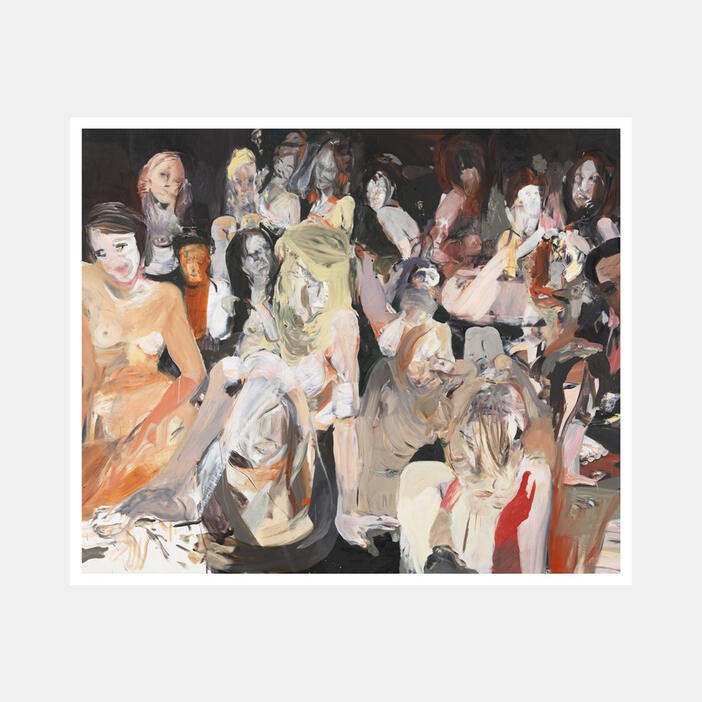

Cecily Brown: All the Nightmares Came Today (2012/2019)
Price AUD$2100.00 | Limited Edition Price CAD$2000.00 | Limited Edition Price £1150.00 | Limited Edition Price €1400.00 | Limited Edition Price USD$1500.00 | Limited Edition Price T1500.00 | Limited Edition
Produced with the support of Kering, a global luxury group committed to the empowerment of women, this charitable limited-edition print is part of a portfolio celebrating Phaidon's Great Women Artists, the most extensive illustrated book on women artists ever published.
The book tells the stories of over 400 artists spanning 500 years and reveals a parallel yet equally engaging history of art for an age that champions a great diversity of voices. The Great Women Artists print portfolio offers collectors the opportunity to acquire affordable works by some of the most celebrated and sought-after women artists of our time, while contributing to a worthy cause. Proceeds will benefit Promundo, a leading organization in advancing gender equality, and preventing violence against women through the education of young boys.
Acquire this print on its own, or collect the entire suite, which includes editions by six artists featured in the book – Cecily Brown, Lubaina Himid, Bharti Kher, Catherine Opie, Jenny Saville, and Dana Schutz – who have worked closely with Artspace, Phaidon, and Kering to contribute works exclusively for the Great Women Artists portfolio.
Specifications:
Edition of 100
This work will come with a signed and numbered archival label adhered to the back of the print
Print: Full color digital archival print on Epson Hot Press Natural 330g/m2
Size: 50.8 cm x 61.0 cm or 20 inches x 24 inches
British painter Cecily Brown has been based in New York since the 1990s, when she rose to prominence as a leading figure in the contemporary painterly canon. Brown’s paintings demonstrate a unique combination of abstraction and figuration, transcending classical notions of genre and narrative by drawing on a wide range of art historical references. Variably inspired by the fantastical visual worlds of Bosch and Goya, the organizational principles of Hogarth, and the gestural expressionism of de Kooning, Brown creates energetic and atmospheric canvases that swirl with fragmented bodies.
Cecily Brown’s work is included in public collections such as the Guggenheim Museum, New York, the Whitney Museum of American Art, New York, the Brooklyn Museum, New York, the Louisiana Museum, Denmark, the National Gallery of Norway, the Tate Gallery, London, Glenstone Museum, Potomac, and the Foundation Louis Vuitton, Paris. In 2018 &ndash 2019, the Louisiana Museum of Modern Art in Copenhagen presented CECILY BROWN: Where, When, How Often and with Whom, a twenty-year survey of Brown’s paintings, drawings, and prints. A major exhibition of new paintings was shown at Blenheim Palace in Oxfordshire, England, from September 2020 to January 2021. Referencing masterpieces from the Palace’s permanent art collection, the exhibition explored the nostalgia surrounding British heritage and the stately home.
Cecily Brown (b. 1969, London) is one of the most celebrated artists working in painting today. Brown draws from the compositional structure, historical motifs, and virtuosic brushwork of master painters across a diverse range of genres. Using a palette ranging from bright hues to deep blacks, her works obscure singular readings as their compositions break down into restless, anfractuous, and elusive activity.
Recent notable one-person exhibitions include “Based on a True Story,” Kestner Gesellschaft, Hannover (2010); “Rehearsal,” The Drawing Center, New York (2016); “If Paradise Were Half as Nice,” Instituto Tomie Ohtake, São Paulo (2018); “Where, When, How Often and with Whom” at the Louisiana Museum of Modern Art, Humlebæk, Denmark (2018); and a major exhibition of new paintings hung at Blenheim Palace, UK (2020–2021). Cecily Brown’s work is included in public collections such as the Guggenheim Museum, New York, the Whitney Museum of American Art, New York, the Brooklyn Museum, New York, the Louisiana Museum, Denmark, the National Gallery of Norway, the Tate Gallery, London, Glenstone Museum, Potomac, and the Foundation Louis Vuitton, Paris.
&ndash Courtesy of Paula Cooper Gallery